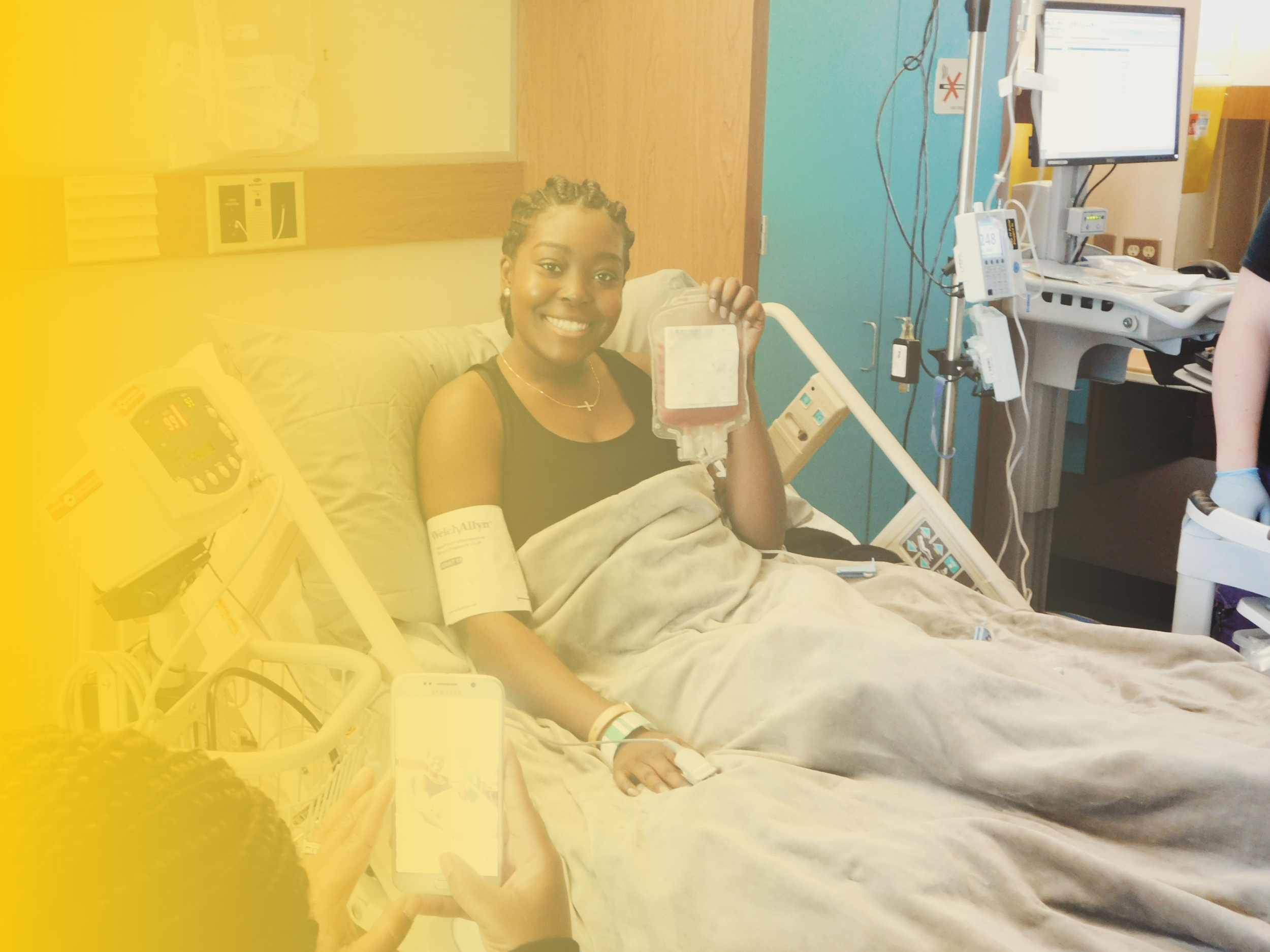
WHAT IS Sickle
Cell Disease?
Sickle cell disease is a group of hereditary red blood cell disorders that causes red blood cells to form into rigid, stick and crescent shapes. Scroll down to find out more about the disease, its symptoms, diagnosis, cures, treatments, and preventative measures.

Learn the basics.
Welcome to your first stop on the road to learning all about sickle cell disease, how it affects those we care about, what you can do to help, and what you can do to help NJY continue to fulfill our mission.
You can either start with the Blood Basics or go straight into learning about Sickle Cell Disease.
Blood BAsics
Sickle cell disease is a group of hereditary red blood cell disorders. The disease causes red blood cells to lose their round flexible shape and form rigid stick and crescent shaped blood cells, hence the description “sickle cell.” As a result of this irregular shape, these blood cell often cannot properly flow through blood vessels, resulting in the slowing or stopping of blood flow and prevention of oxygen delivery to parts of the body.
Select an option to learn more about the role of blood in this disease.
Blood components
-
Main Function: help fight infection in the body
Types: lymphocytes, neutrophils, monocytes, eosinophils, basophils
-
Main Function: help blood clotting
-
Main Function: transport nutrients, hormones, proteins, and waste
-
Main Function: carry oxygen throughout the body
Blood Type AND
Compatibility
A blood type is a categorization of blood used to identify different use cases for blood donation and delivery/exchange of blood products; blood types are determined by inherited genetic factors. Cross-matching is a commonly practiced laboratory test that verifies blood compatibility, to ensure successful use of blood products.

Blood
Donation
-
Blood and blood products are a critical part of everyday medical care including major surgeries, medical procedures, cancer treatments and managing diseases and disorders.
Blood transfusion is the process of transferring blood products into one's circulation intravenously. Transfusions are used for various medical conditions to replace lost components of the blood
Blood Transfusions are crucial treatments for patients with sickle cell disease.
-
It is a way of supporting the sickle cell community, as well as all other communities affected by various illnesses. Blood banks are always in need of more blood products!
-
Once you have located your local blood donation bank and booked an appointment, it’s important to know how to prepare for a blood donation. These are our 3 tips:
Have something to eat in the hours before you donate. Avoid fatty foods such as bacon or fried foods.
Drink at least 500 ml of water.
Have a snack just before donating; preferably salty.
SICKLE CELL DISEASE
Sickle cell disease is a group of hereditary red blood cell disorders. The disease causes red blood cells to lose their round flexible shape and form rigid stick and crescent shaped blood cells, hence the description “sickle cell.” As a result of this irregular shape, these blood cell often cannot properly flow through blood vessels, resulting in the slowing or stopping of blood flow and prevention of oxygen delivery to parts of the body.
Select an option to learn more about how the symptoms, diagnosis, and treatments:
What is Sickle Cell Disease?
-
Sickle cell disease is more prominent in individuals of Sub Saharan African descent. Research has shown the condition to be prevalent in people originating from areas with endemic malaria, including Africa, the Caribbean, the Middle East, South Asia, the Mediterranean, and South and Central America.
The high frequency of SCD in regions with endemic malaria is believed to be the result of sickle cell trait’s (HbAS) protection against malaria. Sickle cell trait provides significant protection against some malaria symptoms and death by malaria.
-
Sickle Cell Trait is the condition in which an individual only inherits the hemoglobin S gene (HbS) from one parent. Individuals with sickle cell trait, also known as sickle cell carriers.
The term sickle cell carriers refers to the fact that individuals with the sickle cell trait, can pass their trait down to their children. Because the sickle cell trait is a recessive gene, when two individuals who have the sickle cell trait have a child there is a 50% (1 in 2) chance that any child of theirs will inherit the sickle cell trait as well. When two individuals with sickle cell trait have a child there is a 25% (1 in 4) chance that the child will inherit sickle cell disease, and there is the same 25% chance that the child will not inherit sickle cell disease or sickle cell trait.
-
Sickle Cell Anemia (also known as hemoglobin SS disease)
Caused by the hemoglobin known as Hb SS. As the most severe form of SCD, individuals with this form experience the severe symptoms at a higher rate.
Sickle-hemoglobin C Disease (also known as hemoglobin SC disease)
Caused by the hemoglobin known as Hb SC. Those with this form of sickle cell have red blood cells that contain both hemoglobin S and hemoglobin C.
People who have hemoglobin C disease have red blood cells that contain mostly hemoglobin C. Too much hemoglobin C can reduce the number and size of red blood cells in your body, causing mild anemia. Hemoglobin C disease usually does not cause serious health problems.
Sickle Beta Thalassemia Disease (Sβ+ or Sβ0)
Affected individuals have a mutation in each copy of their hemoglobin genes: one that causes red blood cells to form a "sickle" or crescent shape and a second that is associated with beta thalassemia, a blood disorder that reduces the production of hemoglobin. Individuals with sickle beta plus thalassemia have less severe symptoms than those with sickle beta zero thalassemia. Those with sickle beta zero thalassemia have more severe symptoms and symptoms are similar to those with sickle cell anemia.

Get Screened For
Sickle Cell Trait
Since those with sickle cell trait do not usually experience any symptoms of sickle cell disease, individuals end up passing the disease onto their children unknowingly. With a simple screening, you can prevent a child from being born with sickle cell disease in the future.
Symptoms Of Sickle Cell Disease
Individuals with sickle cell disease are subject to a plethora of symptoms which vary from person to person and even change over time. Some might experience:
-
Caused by abnormal hemoglobin found in sickle cells, these blood cells are short-lived causing a shortage of red blood cells in one’s body.
-
Periodic episodes of pain caused by Vaso-occlusion. Vaso-occlusion occurs when sickle cells cannot pass through small blood vessels due to their shape and rigidity. This prevents proper blood flow in blood vessels traveling to various areas of the body. Individuals with sickle cell may experience severe pain in their chest, abdomen, joints and bones.
-
Any and all major organs can be affected by sickle cell disease. The liver, heart, kidneys, gallbladder, eyes, bones, and joints may be subject to damage from the abnormal function of the sickle cells and their inability to flow through blood vessels correctly. SCD can cause some individuals to experience:
Dilated cardiomyopathy: a condition in which the heart becomes enlarged
Coronary heart disease
Pulmonary hypertension (a type of high blood pressure)
Chronic kidney disease
Splenic sequestration: occurs when many red blood cells become trapped in the spleen resulting in spleen enlargement, damage, and loss of function.
Frequent blood transfusions may also cause heart damage and other organ damage from iron overload.
-
Due to the reduced spleen function, individuals with SCD have an increased susceptibility to infection, including serious respiratory infections.

Diagnosis, Treatments,
and Cures
-
Antibiotics & Vaccines - to prevent infection
Pain-relieving medications
Hydroxyurea
Aids in fetal hemoglobin production, which prevents the formation of sickle cells. Hydroxyurea is used to reduce the frequency of painful crises and reduce the need for blood transfusions.
-
Regular blood transfusions can increase the oxygen-carrying capacity of blood and reduce the complications of vaso-occlusion.
-
Since red blood cells are produced in the bone marrow, currently, the only cure for sickle cell is a bone marrow transplant (BMT). A BMT is a procedure that replaces bone marrow that produces abnormal red blood cells with healthy bone marrow. This involves the transplanting of blood stem cells that will move through the circulatory system to the bone marrow where they are accepted by the body and start the production of new healthy blood cells.
In short, patients are immunocompromised with chemotherapy and total body radiation which is followed by a stem cell transfusion. For more information we recommend visiting a doctor for professional explanation and guidance.
-
CRISPR gene editing is currently being explored as a tool for future therapy
L-glutamine oral powder and Crizanlizumab to reduce the frequency of pain crises (Not approved in Canada)
Voxelator to improve anemia (Not approved in Canada)






